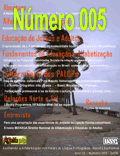Aprender a Ler o Mundo: adaptação do método de Paulo Freire na alfabetização de crianças
DOI:
https://doi.org/10.11606/issn.1980-7686.v3i5p22-37Palavras-chave:
Freire, literacia, palavras geradoras, pedagogia críticaResumo
Ao visitar escolas como supervisora pedagógica, a investigadora notou que as aulas de recuperação em alfabetização eram uma continuidade das aulas regulares e, numa tentativa para procurar soluções para alfabetizar as crianças analfabetas, planificou uma investigação-ação, em que ela atuou como professora, fundamentada na pedagogia crítica de Freire. Numa escola de 218 alunos, a investigadora escolheu 14, oficialmente situados em classes avançadas mas, na realidade, analfabetos, e convidou-os para uma turma especial onde ela tentou ensiná-los a ler e escrever, sua intervenção ocorreu durante 48 horas, sendo duas vezes por semana, quatro horas de cada vez. As actividades foram precedidas de intenso diálogo entre os estudantes e a investigadora-professora, pois esta reconhece a importância fundamental da oralidade na prática da alfabetização. Mas aquela participação oral permitiu também conhecer os temas da vida real dos estudantes e as "palavras geradoras" correspondentes, de modo a fazer aumentar a sua consciência crítica, como propõe Freire.Downloads
Os dados de download ainda não estão disponíveis.
Downloads
Publicado
2009-02-01
Edição
Seção
Alfabetização de Crianças
Licença
Apenas el trabajo es aceptado por el Consejo y la Comisión Editorial, los autores se comprometen a transferir los derechos de autor para la revista "Acolhendo a Alfabetização nos Países de Língua Portuguesa". |
Como Citar
Leite, O. S. L., & Duarte, J. B. (2009). Aprender a Ler o Mundo: adaptação do método de Paulo Freire na alfabetização de crianças . Acolhendo a Alfabetização Nos Países De Língua Portuguesa, 3(5), 22-37. https://doi.org/10.11606/issn.1980-7686.v3i5p22-37


